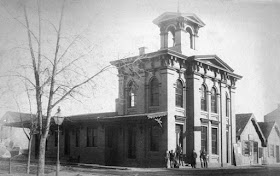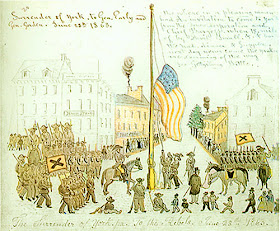I believe we will create a better world, someday – just probably not while I am still breathing in it. My personal philosophy can best be expressed as a “depressed optimist”. Case in point - recent research of the 3 inch fossil Fuxianhuia protensa, (above) has postulated that about half a billion years ago, as the autotrophs were beginning to drool, they suffered a glitch during mitosis or meiosis, or some sort of reproduction, and begot a double pair of a particular genomic sequence in their proto-brains, and then passed that “oops” down to their daughter cells. As Neanderthals developed tools, this “double dose” of DNA strands gave rise to higher brain functions in humans. Evidently, it also gave rise to crazy.
As one brainiac involved in this study put it, “The price of higher intelligence and more complex behaviors is more mental illness.” What this implies is that whether you are studying religion or astronomy, Descartes or Deuteronomy, you are ingesting a degree of insanity right along with all the knowledge you acquire. The ability to use fire allowed us to break down meat proteins, but that also bestows the ability to burn down the house you live in. And we do it all the time – ask any Tea Party Member. Music or mythology, Einstein or astrology, nothing that humans have ever invented could not be used to destroy humans. Why should the Internet be any different from that?
You see some idiots have exploited a “hole” in the Java software system, putting, according to the United States Department of Homeland Security, one billion computers at risk, both Apple and Windows systems, and Chrome, Firefox, Safari and Explorer browsers. According to TechNews Daily, Java has offered an emergency fix, but it means “ users will have to approve every single instance of Java that they encounter online.” In other words, the $8 trillion web is being destroyed because somebody found out a way to make 50 cents profit by blowing it up.
My question is , what kind of idiot would try to make a profit from destroying all future profits? But the answer is obvious. The same kind of idiots who blew up the world wide economic system in 1929 and again in 2007, the same kind of idiots who are currently running the National Rifle Association, seemingly determined to convince the vast majority of Americans that the terms “gun owner” and “gun nut” are synonymous. As a famous fictional American once said, “Stupid is as stupid does”.
On the plus side, I also recently came across research from South Africa and Sweden, which reveals that the average dung beetle uses GPS in rolling their poop balls back home. But this G in GPS does not stand for global, but for galactic. We've always known that once the lady beetle gets a nice juicy ball of dung together, they climb on top and do a little dance. Entomologists assumed it was the beetle's way of saying to the universe “This ball of crap is mine!” But now it seems they are actually seeking to orientate themselves so they can find their way back to their burrow. If the sun is up, they use the sun. At night they use the moon. And on moonless nights they use the Milky Way, that smear of billions of stars that runs across the night sky, that nobody ever figured a dung beetle was even aware of..
According to Professor Marcus Bryne, from Wits University in Johannesburg, “The dung beetles don't care which direction they're going in; they just need to get away from the big fight with the other beetles at the poo pile.” And there appears to be a lesson on the relationship between Newtonian and Quantum physics here. The beetles can use the Milky Way to define a straight line back to their burrows, because they are so small, and the Milky Way is so far away. However, a moth, using the same basic methodology, circles a flame because they are bigger and closer to the light source. In other words, the moths think they are flying in a straight line, as long as they keep the light at an equal distance. Its the difference between walking from New York and Los Angeles, and flying there. It's the Flatland thought experiment, but with moths and poop, rather than circles and triangles.
But to get back to my original example, Fuxianhuia protensa, has been described as a “missing link”, or more accurately as “a mistaken link”. The problem is the little multi-legged beetle, which an average human would instantly step on if they spotted it in their closet, might have been the ancestor of all bugs – crickets, cockroaches, beetles, moths and honey bees. But it also might not. I probably better explain my last statement, or rather let Professor Nicholas Strausfeld from the University of Virginia explain it. “There has been a very long debate about the origin of insects,” he says. And that, it seems, explains everything.
See, to put it simply, the grandaddy of all buggies was either a crab or a sea monkey (brine shrimp if you are over the age of twelve). Crabs are crustaceans, and sea monkey's are branchiopods. Crabs have much more complex bodies than do sea monkeys. So, ancient sea monkeys were thought to have evolved into insects, while ancient crabs evolved into everybody else. Or so the thinking used to go. But then along comes Fuxianhuia protensa, with a squiggly body and an organized brain, and a dependable dated age of 520 million years old. And that is old enough to have been the great-great-great-etcettera-granddaddy of both – which means that life got smart and then found it might be more advantageous to get stupid again, but with fewer legs..
I can dig that. I can even empathize with how the little buggies felt. Every human male reaches some point in their lives when they realize that women often prefer bastards to nice guys. As your father might have told you at that point, “Life isn't fair”, and he may even have asked you, “If you ever figure women out, will let me know?” To put it in a more gender neutral way, most people reach a point when they suspect that their brains are just getting in the way of their hormones making them happy. And it appears that sometime in the Cambrian period, the squiggly crawly things wiggling across the ocean floor first confronted that basic philosophical conundrum: brains or balls? Which way will I go?
At that point it now appears that the balls returned to a simpler brain and instant gratification, while the brains tried the deferred reward path. And the amazing thing is, it appears we both ended up in the same place, standing atop a pile of our own shit and looking to the Milky Way for direction.
It's enough to make anybody a depressed optimist.
- 30 -























































